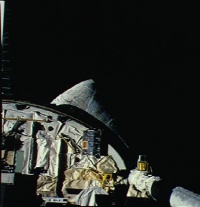Bremsat
From The Space Library
 | |
| Organization | German Space Agency (Federal Republic of Germany) |
|---|---|
| Mission type | Earth Science,Microgravity,Space Physics |
| Launch date | February 3, 1994 |
| Launch vehicle | STS-60 |
| Carrier rocket | Space Shuttle |
| Launch site | Cape Canaveral, United States |
| COSPAR ID | 1994-006H |
| Mass | 63.0 kg |
| Alternate Names | 22998 |
| Additional Information | Here |
| PDMP Information | Here |
| Telecommunications Information | Here |
This 63-kg German microsatellite was built by the University of Bremen's Center of Applied Space Technology and Microgravity (ZARM) under sponsorship of the German Space Agency (DARA). It is 12-sided, with 48-cm diameter and height of 52 cm, and was injected into orbit (from a GAS canister) from STS-60 into a 363 x 344 km orbit, inclined at 56.9 degrees. The mission consisted of three phases: microgravity (on board the Shuttle before ejection into orbit), orbital, and re-entry. The scientific objectives were to measure heat conductivity, measure residual acceleration forces, estimate the in-orbit on-board microgravity quality, investigate the density distribution and dynamics of micrometeorites and dust particles in low-Earth orbit, map atomic oxygen, measure the exchange of momentum and energy between the molecular flow and the rotating satellite, and measure pressure and temperature during satellite re-entry. The satellite included a momentum wheel and magnetic coils, a magnetometer, and sun-star sensors. Tracking passes lasted 5-10 minutes and ocurred 5-6 times per day. The spacecraft re-entered 12 February 1995.
